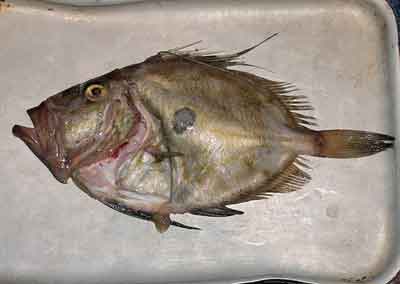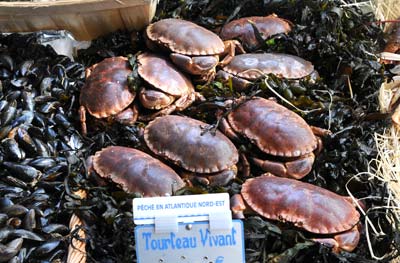The Dordogne is a department formed in 1790 from, and roughly equivalent to Périgord and part of Aquitaine. It is also the name of the river which gives the department its name. The west, especially in the river valleys, is fertile and vines and wheat are cultivated. The Dordogne is known for its chestnuts, walnuts and truffles.

John Dory. A high quality, plump, flattish fish with a golden sheen, and an ugly but amiable face. It was first associated with Zeus, then with St Peter, as evidenced by the ‘finger marks’ left by him when he picked it up to remove a coin from its mouth to pay some taxes.
This indicates that cucumber is included in the dish. It can mean that the colours of the Italian flag are used in a dish (red, green and white) or that a dish contains truffles from Piedmont.
Bleak, a small, elongated, white-fleshed fishof the same family as minnows and carp, abundant in lakes and quiet waterways. Its scales, which are thin and silvery, come away easily. The flesh of the pond bleak is of poor quality but that of the river variety is fairly good, although it is full of little bones. It is about 15 cm (6 inches) long and invariably served fried. It may also be called able though this is actually a different fish. May be mistaken for the able or gardon.

The edible crab measuring as much as 20 cm (8”) across. This is a beast with well flavoured, succulent brown and white meat. I prefer a good fresh crab to lobster, though a good fresh lobster will do! The brown meat is held inside the carapace or shell, while the white meat is found, with a little effort, in the claws. It is fished in the eastern side of the Atlantic rather than the Mediterranean but is available in markets not on the Atlantic.
A dry, strong goat's milk farmhouse cheese with a natural rind, sometimes made with a mixture of cow and goat's milk, made in the vicinity of Dornecy in Nivernais. Best in summer and autumn.
The neck of a Champagne bottle is frozen in a brine bath called bac à glace in preparation for dégorgement, the removal of sediment from the bottle. This immediately precedes "dosage" in the méthode champenoise. Dosage, or liqueur d'expedition, is the addition of a mixture of wine and sugar which determines the eventual sweetness of the contents of the bottle, which is then corked.